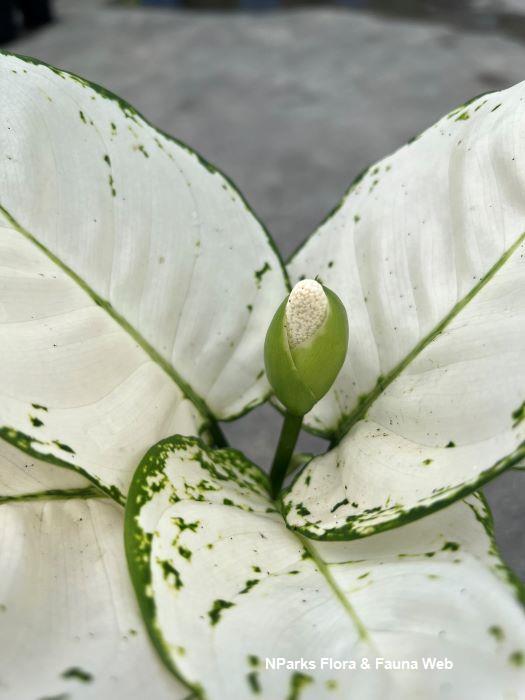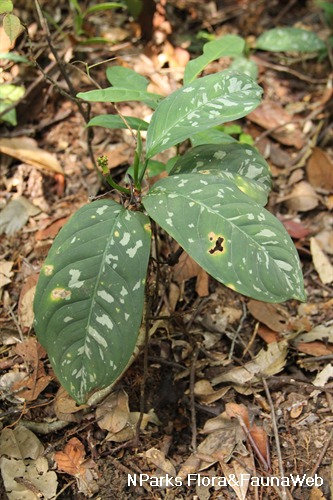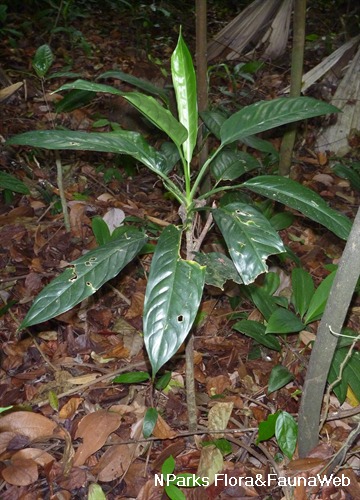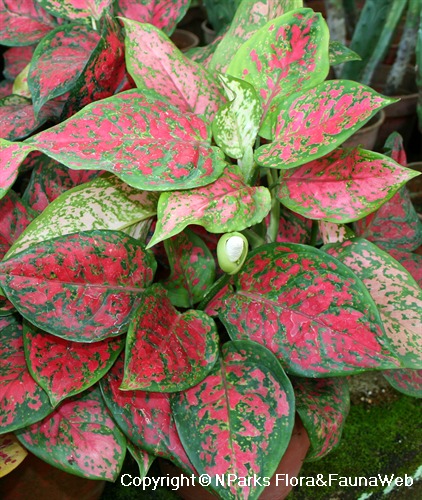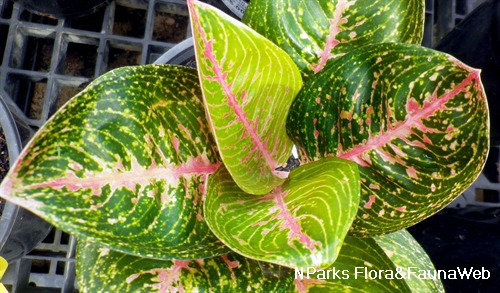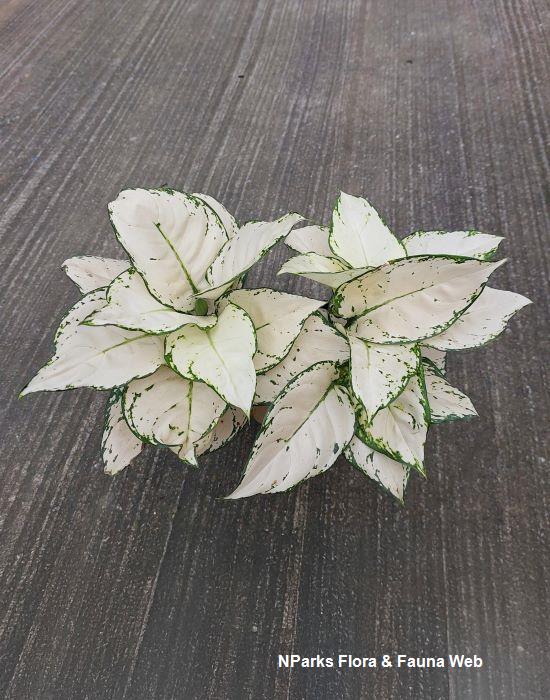
Back
Aglaonema 'White Joy'
| Family Name: | Araceae |
Aglaonema 'White Joy' is an easy-to-grow cultivar that produce variegated leaves that are mostly white with green margins and midrib. This ornamental plant is suitable for indoor container planting. Keep away from bright, direct sunlight.
Name
Classifications and Characteristics
| Plant Division | Angiosperms (Flowering Seed Plants) (Monocotyledon) |
|---|---|
| Plant Growth Form | Herbaceous Plant |
| Lifespan (in Singapore) | Perennial |
| Mode of Nutrition | Autotrophic |
| Maximum Height | 0.3 m to 0.5 m |
Biogeography
| Native Habitat | Terrestrial |
|---|---|
| Preferred Climate Zone | Tropical |
| Local Conservation Status | Non-native (Horticultural / Cultivated Only) |
Description and Ethnobotany
| Growth Form | It is a herbaceous plant that can grow up to 0.3 - 0.5 m in height. |
|---|---|
| Foliage | The leaves are broadly egg-shaped that tapers into a soft tip. The leaves are mostly white or off-white with green margins, midrib, and irregular spots. The petiole (leaf stalk) is green with faint irregular patches of white or off-white. Lower leaves are often shed, exposing the stem. |
| Flowers | The inflorescence is a white spadix, and subtended by a green spathe. |
| Cultivation | It grows best in bright, indirect sunlight or semi-shade and prefers moist, well-draining, loamy soil. Although it tolerates heavy shade, the plant may grow leggy over time. Keep away from bright, direct sunlight to prevent leaves from scorching. |
| Etymology | The generic epithet Aglaonema is derived from Greek aglaos, "bright" and nema, "thread", possibly referring to the stamens. |
Landscaping Features
| Landscaping | It is suitable for planting in shaded areas of parks and gardens, underneath tree canopy. |
|---|---|
| Desirable Plant Features | Ornamental Foliage |
| Landscape Uses | Parks & Gardens, Container Planting, Small Gardens, Interiorscape/ Indoor Plant |
| Usage Hazard - Cons | Irritant - Sap, Toxic Upon Ingestion |
| Usage Hazard - Cons Remarks | All parts of plant contains calcium oxalate crystals in their sap, causing mouth and throat irritation if ingested, and possible itchiness if in contact with the skin. Keep away from pets and children. |
Plant Care and Propagation
| Light Preference | Semi-Shade |
|---|---|
| Water Preference | Moderate Water, Occasional Misting |
| Plant Growth Rate | Moderate |
| Rootzone Tolerance | Easy to Grow, Moist Soils, Well-Drained Soils, Fertile Loamy Soils |
| Pest(s) | Sucking Insects |
| Propagation Method | Stem Cutting |
Foliar
| Foliage Retention | Evergreen |
|---|---|
| Mature Foliage Colour(s) | Green, Cream / Off-White, White |
| Mature Foliage Texture(s) | Smooth, Leathery |
| Young Flush Texture(s) | Leathery |
| Foliar Type | Simple / Unifoliate |
| Foliar Arrangement Along Stem | Spiral |
| Foliar Attachment to Stem | Petiolate |
| Foliar Shape(s) | Non-Palm Foliage (Ovate) |
| Foliar Venation | Parallel |
| Foliar Margin | Entire - Wavy / Undulate |
| Foliar Apex - Tip | Acuminate |
| Foliar Base | Cordate |
| Leaf Area Index (LAI) for Green Plot Ratio | 3.5 (Shrub & Groundcover - Monocot) |
Floral (Angiosperm)
| Flower & Plant Sexuality | Unisexual Flowers , Monoecious |
| Flower Colour(s) | White |
|---|
| Flower Grouping | Cluster / Inflorescence |
| Flower Location | Axillary |
| Inflorescence Type | Spathe & Spadix |
| Ovary Position | Superior / Hypogynous |
| Flowering Period | Rarely |
| Flowering Habit | Polycarpic |
Image Repository
Others
| Master ID | 21745 |
|---|---|
| Species ID | 3369 |
| Flora Disclaimer | The information in this website has been compiled from reliable sources, such as reference works on medicinal plants. It is not a substitute for medical advice or treatment and NParks does not purport to provide any medical advice. Readers should always consult his/her physician before using or consuming a plant for medicinal purposes. |

